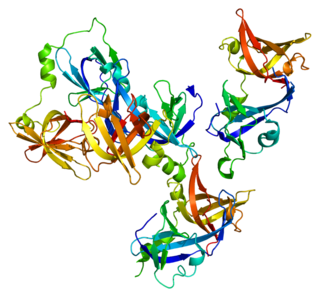Interferon-induced guanylate-binding protein 1 is a protein that in humans is encoded by the GBP1 gene. [3] [4] It belongs to the dynamin superfamily of large GTPases. [5]
Interferon-induced guanylate-binding protein 1 is a protein that in humans is encoded by the GBP1 gene. [3] [4] It belongs to the dynamin superfamily of large GTPases. [5]
Guanylate binding protein expression is induced by interferon. Guanylate binding proteins are characterized by their ability to specifically bind guanine nucleotides (GMP, GDP, and GTP) and are distinguished from the GTP-binding proteins by the presence of 2 binding motifs rather than 3. [4]

Guanylate cyclase is a lyase enzyme that converts guanosine triphosphate (GTP) to cyclic guanosine monophosphate (cGMP) and pyrophosphate:

Chemokine ligand 7 (CCL7) is a small cytokine that was previously called monocyte-chemotactic protein 3 (MCP3). CCL7 is a small protein that belongs to the CC chemokine family and is most closely related to CCL2.

Acyl-CoA-binding protein in humans belongs to the family of Acyl-CoA-binding proteins.

Interferon-induced GTP-binding protein Mx1 is a protein that in humans is encoded by the MX1 gene.

Gamma-interferon-inducible protein Ifi-16 (Ifi-16) also known as interferon-inducible myeloid differentiation transcriptional activator is a protein that in humans is encoded by the IFI16 gene.

Protein farnesyltransferase/geranylgeranyltransferase type-1 subunit alpha is an enzyme that in humans is encoded by the FNTA gene.

Protein farnesyltransferase subunit beta is an enzyme that in humans is encoded by the FNTB gene.

Interferon regulatory factor 5 is a protein that in humans is encoded by the IRF5 gene. The IRF family is a group of transcription factors that are involved in signaling for virus responses in mammals along with regulation of certain cellular functions.

Eukaryotic translation initiation factor 2 subunit 2 (eIF2β) is a protein that in humans is encoded by the EIF2S2 gene.

Glycoprotein V (platelet) (GP5) also known as CD42d, is a human gene.

Bcl-2-associated transcription factor 1 is a Bcl-2 family protein in humans that is encoded by the BCLAF1 gene.

Cdc42 effector protein 1 is a protein that in humans is encoded by the CDC42EP1 gene.

Guanylate cyclase soluble subunit beta-1 is an enzyme that in humans is encoded by the GUCY1B3 gene.

Guanylate cyclase soluble subunit alpha-3 is an enzyme that in humans is encoded by the GUCY1A3 gene.

Interferon-induced guanylate-binding protein 2 is a protein that in humans is encoded by the GBP2 gene. GBP2 is a gene related to the superfamily of large GTPases which can be induced mainly by interferon gamma.

Immunity Related Guanosine Triphosphatases or IRGs are proteins activated as part of an early immune response. IRGs have been described in various mammals but are most well characterized in mice. IRG activation in most cases is induced by an immune response and leads to clearance of certain pathogens.

Interferon alpha-16, also known as IFN-alpha-16, is a protein that in humans is encoded by theIFNA16 gene.

In molecular biology, the guanylate-binding protein family is a family of GTPases that is induced by interferon (IFN)-gamma. GTPases induced by IFN-gamma are key to the protective immunity against microbial and viral pathogens. These GTPases are classified into three groups: the small 47-KD immunity-related GTPases (IRGs), the Mx proteins, and the large 65- to 67-kd GTPases. Guanylate-binding proteins (GBP) fall into the last class. In humans, there are seven GBPs (hGBP1-7). Structurally, hGBP1 consists of two domains: a compact globular N-terminal domain harbouring the GTPase function, and an alpha-helical finger-like C-terminal domain. Human GBP1 is secreted from cells without the need of a leader peptide, and has been shown to exhibit antiviral activity against Vesicular stomatitis virus and Encephalomyocarditis virus, as well as being able to regulate the inhibition of proliferation and invasion of endothelial cells in response to IFN-gamma.
The cGAS–STING pathway is a component of the innate immune system that functions to detect the presence of cytosolic DNA and, in response, trigger expression of inflammatory genes that can lead to senescence or to the activation of defense mechanisms. DNA is normally found in the nucleus of the cell. Localization of DNA to the cytosol is associated with tumorigenesis, viral infection, and invasion by some intracellular bacteria. The cGAS – STING pathway acts to detect cytosolic DNA and induce an immune response.

Guanylate binding protein family member 6 is a protein that in humans is encoded by the GBP6 gene.